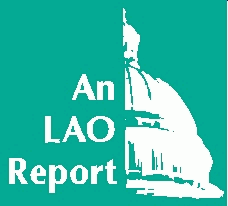
 |
LAO Recommended Legislation |
Provide annual cost-of-living adjustments (COLAs) on a sliding scale larger for low-wealth districts rather than the current approach of fixed amounts per student regardless of whether districts are rich or poor.
Providing higher COLAs for low-wealth districts, over time, will help eliminate the per-student funding disparities that exist among districts. Under the current COLA approach, funding disparities shrink slowly and never entirely disappear.
Please see our 1997-98 Analysis, page E-61.
Robert Turnage or Jannelle Lee: 445-8641
Enact law changes, phased-in over a three-year period, to eliminate incentives that lead to costly and inappropriate placement of probation-referred students to county community schools.
Our proposal would eliminate counter-productive incentives under current funding formulas that lead to these inappropriate placements of pupils in county community schools. This change would encourage districts to place many of these pupils in school district alternative programs which are less costly and are more likely to meet the needs of students. For those pupils appropriately assigned to community schools, who are the type of pupils most in need of adult supervision, our proposal would increase the hours of adult supervision per school day from four to six.
Please see our 1995-96 Analysis, page E-64.
Robert Turnage or Mary Jones: 445-8641
Phase out "basic aid" given to high-property-wealth districts, over a three-year period.
So-called basic aid school districts are among the districts with the highest amounts of combined state/local revenues per student. They are not in need of the additional state aid provided by basic aid payments. The provision of basic aid to these districts exacerbates the disparities in per-student funding that the Legislature perennially tries to address through equalization funding. The amount currently spent on basic aid to those districts (an estimated $10 million in 1997-98) could be used instead to address higher priority educational needs.
Please see our 1997-98 Analysis, page E-64.
Robert Turnage or Jannelle Lee: 445-8641
Consolidate and simplify the current plethora of categorical programs into a discrete number of manageable and flexible block grants.
The state currently funds more than 60 categorical programs, each with detailed requirements and amounts that cannot fully account for local variations in needs. Consolidating many of these programs into several block grants would eliminate unnecessary "red tape," and free local districts and schools to address their needs in ways that best match their local circumstances. Money would flow more readily to those activities for which it is needed most, leading to more effective use of funds. Under this proposal, state oversight would focus on the contribution made by block grant funds to improving student achievement and other educational outcomes.
Please see our 1997-98 Analysis, page E-70.
Robert Turnage or Jannelle Lee: 445-8641
Require school districts to use the same number of teachers mandated by the current class size reduction (CSR) program, but allow schools to deploy teachers as best meets students' needs, rather than the rigid 20 to 1 formula for each classroom required by current law. This proposal would not decrease funding for CSR; it would provide for more flexible and effective implementation.
One size does not always fit all. Our proposal for increased flexibility could help schools improve educational outcomes. For example, our proposal would permit one-on-one or small group tutoring to supplement classroom instruction, something that is impractical under current CSR constraints. Our proposal also would alleviate counter-productive side-effects of the current rigid formula, such as the busing of children among schools in order to assure that each classroom in each school not exceed 20 children. It also would ease the problems that participation in the program poses for schools with serious facilities constraints.
Please see our 1997-98 Analysis, page E-52.
Robert Turnage or Rob Manwaring: 445-8641
Develop strategy to take advantage of federal tax credits by selective increases in higher education fees. These increases would be offset substantially in some cases completely by higher federal tax credits for students. For low-income students, fee increases could be offset fully by increased financial aid.
Federal law allows the Legislature to increase federal support of state higher education. Additional funds could be used to improve programs and increase student access at little or no cost to students/families.
Failure to act will unintentionally shift enrollment away from community colleges to the universities at significant costs to the state and at cross purposes with the state's higher education master plan.
Please see our report, Taking Advantage of New Federal Higher Education Tax Credits (February 1998).
Buzz Breedlove: 445-8641
Return to 1999 Recommended Legislation